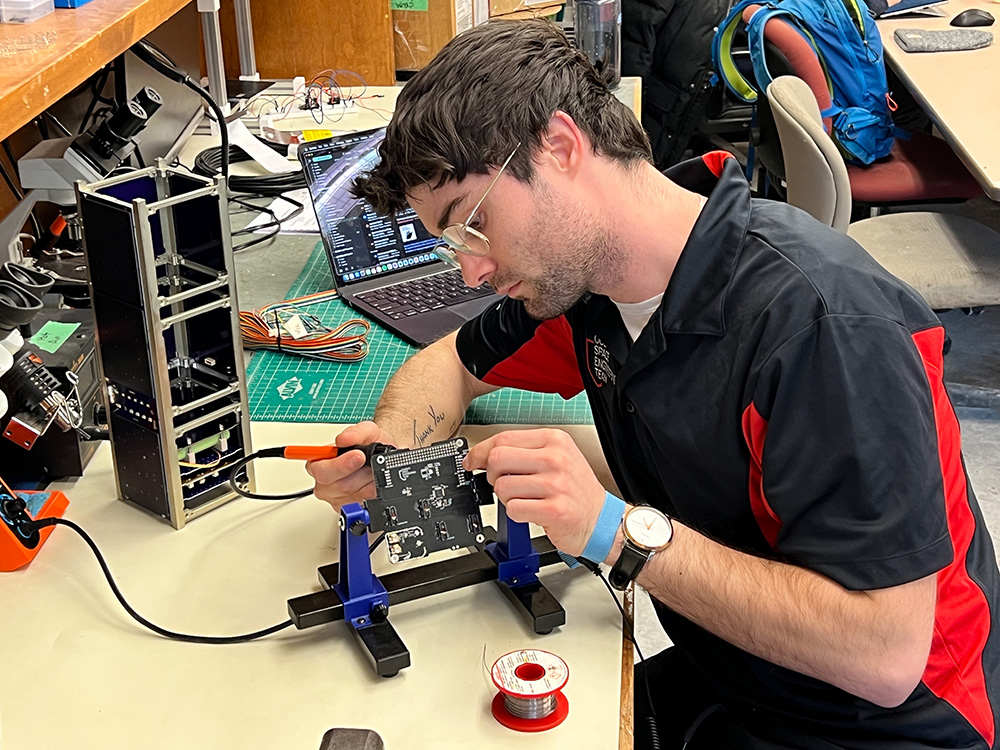Owen Hooper is in his final term as an undergraduate student of Computer Engineering, but he still clearly recalls the design team showcase event he attended back in first year during orientation week. He’d always loved robots, and as he wandered around the displays and presentations that night, he was impressed overall with the different automatons he saw.
But only one team had a moving robot: Queen’s Space Engineering Team (QSET).
“Other teams had robots, but they weren’t turned on or they didn't work,” he says. “QSET’s robot was there, moving around, doing things, and I knew I wanted to be part of that.” And he has been ever since.
Hooper is now the co-Chief Technical Officer (CTO) of QSET and oversees the Rover Team, which builds a mock Mars rover for the annual University Rover Challenge in Utah. His co-CTO is Sean Tedesco, who helps lead the Satellite Team in the building of a small satellite that competes at the annual Canadian CubeSat Design Challenge and which may someday be launched into space.
There are approximately 200 QSET members this year. Though they are split between the two teams, they all share the same resources, including a small office and a larger workspace in Beamish-Munro Hall.
The two teams are always bumping ideas off each other, says Tedesco. “It’s a pretty even compromise and a very shared environment.”
“Rover is a bit messier than satellite is, though,” says Hooper with a laugh.

That Rover “mess” is largely dedicated to making big changes to the vehicle every year, so that it can do things like navigate on its own through rough terrain and operate dexterous robotic arms. The modifications this year have included redesigning the wheels, designing and manufacturing a new scientific payload, updating the software on the robotic arms, and improving the autonomous systems.
Hooper says his experience with QSET has not only spurred his interest in robots but has led to a couple internships in the robotics space. “Without QSET, I would not have had exposure to a large robotic system and been able to program it and see it work out in the field. And being able to do that and iterate on a real physical system is really what allowed me to set myself apart.”
Over on the Satellite side, the team is in the middle of the nine-year cycle it usually takes to build the fully functioning satellite and launch it into space. They are beginning to transfer all the specifications and calculations they have made on paper into the actual mechanical systems that make up the satellite. When they are done, the orbiter will be about the size of a two-litre carton of milk. Its mission: to give people access to a public satellite that allows them to send and receive images of Earth.
It’s been a blast, says Tedesco, who has career aspirations of building satellites and satellite missions. “I definitely think being the CTO now is bringing me one step closer.”
One big lesson Tedesco has learned with QSET: compromise. “These are complex systems and you always have these trade offs to handle,” he says. “So it’s been quite a lot of fun to work through those compromises that you make in your design.”
For Hooper, a big takeaway has been the importance of getting hands-on experience. “Joining a design team is probably the best decision you can make as an undergraduate student,” he says. “Sure, courses have labs and there’s the annual project, but this lets a student work with a larger team on a larger project, doing things that we might not be taught in the classroom.”
